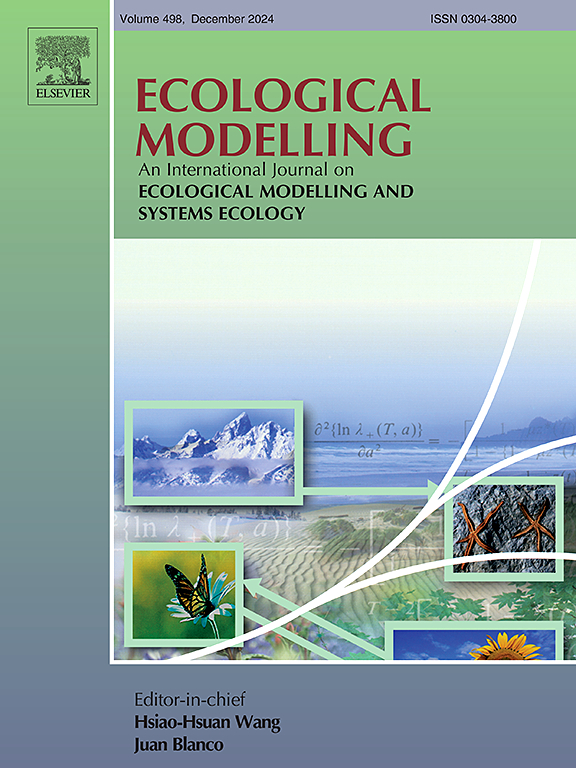Utilizing spatial modeling to evaluate habitat suitability and develop conservation corridors for effective conservation planning of Asian elephants (Elephas maximus) in Jeli, Kelantan, Malaysia
IF 2.6
3区 环境科学与生态学
Q2 ECOLOGY
引用次数: 0
Abstract
Forest loss and habitat fragmentation threaten Asian elephants by isolating populations, hindering species movement, disconnecting habitat patches, and changing ecological processes. Constructing ecological corridors are considered critical initiatives to conserve Asian elephants by restoring and strengthening connectivity. Although most studies effectively assess habitat suitability for elephants and identify potential conflict areas with humans, they often fall short of utilizing this information to create effective ecological corridors. Therefore, this study aims to determine the potential ecological corridors by considering the conflict area and suitability of Asian elephant habitat in Jeli, Kelantan. In this study, habitat suitability was developed using MaxEnt software, considering seven variables, where distance from the river was identified as the highest contribution to the habitat suitability of Asian elephants, followed by elevation and LULC. The habitat suitability map was then converted to a landscape resistance map, which was used to predict the potential ecological corridors for Asian elephants. The circuit theory and least-cost path were integrated using the Circuitscape software to identify a suitable corridor for Asian elephants. The habitat suitability analysis shows that only 15 % of the study area is suitable for elephants. 50 % of the area is unsuitable because it is far from water sources. The corridor analysis shows that ten suitable corridors were constructed in this study. The longest corridor is 1705 m, while the shortest is 230 m. Thus, suitable habitat conditions, well-connected and well-designed corridors are crucial for elephant populations to survive in a fragmented landscape, mitigate human conflicts, and encourage sustainable and harmonious coexistence.
利用空间模型评估马来西亚吉兰丹吉里亚洲象栖息地适宜性并开发保护走廊,为有效的保护规划提供依据
森林损失和栖息地破碎化通过隔离种群、阻碍物种运动、断开栖息地斑块和改变生态过程来威胁亚洲象。建设生态走廊被认为是通过恢复和加强连通性来保护亚洲象的重要举措。尽管大多数研究都有效地评估了大象栖息地的适宜性,并确定了与人类的潜在冲突地区,但它们往往无法利用这些信息来创建有效的生态走廊。因此,本研究旨在通过考虑吉兰丹吉里亚洲象栖息地的冲突区域和适宜性,确定潜在的生态走廊。在本研究中,使用MaxEnt软件开发了栖息地适宜性,考虑了7个变量,其中确定与河流的距离是对亚洲象栖息地适宜性贡献最大的变量,其次是海拔和LULC。然后将栖息地适宜性图转换为景观阻力图,用于预测亚洲象潜在的生态走廊。利用Circuitscape软件将电路理论和最低成本路径相结合,确定了适合亚洲象的走廊。生境适宜性分析表明,只有15%的研究区域适合大象生存。由于远离水源,50%的地区不适合居住。廊道分析表明,本研究构建了10条适宜的廊道。最长的走廊长1705米,最短的走廊长230米。因此,适宜的栖息地条件、连接良好、设计良好的走廊对于大象种群在碎片化景观中生存、缓解人类冲突、促进可持续和谐共处至关重要。
本文章由计算机程序翻译,如有差异,请以英文原文为准。
求助全文
约1分钟内获得全文
求助全文
来源期刊

Ecological Modelling
环境科学-生态学
CiteScore
5.60
自引率
6.50%
发文量
259
审稿时长
69 days
期刊介绍:
The journal is concerned with the use of mathematical models and systems analysis for the description of ecological processes and for the sustainable management of resources. Human activity and well-being are dependent on and integrated with the functioning of ecosystems and the services they provide. We aim to understand these basic ecosystem functions using mathematical and conceptual modelling, systems analysis, thermodynamics, computer simulations, and ecological theory. This leads to a preference for process-based models embedded in theory with explicit causative agents as opposed to strictly statistical or correlative descriptions. These modelling methods can be applied to a wide spectrum of issues ranging from basic ecology to human ecology to socio-ecological systems. The journal welcomes research articles, short communications, review articles, letters to the editor, book reviews, and other communications. The journal also supports the activities of the [International Society of Ecological Modelling (ISEM)](http://www.isemna.org/).
 求助内容:
求助内容: 应助结果提醒方式:
应助结果提醒方式:


